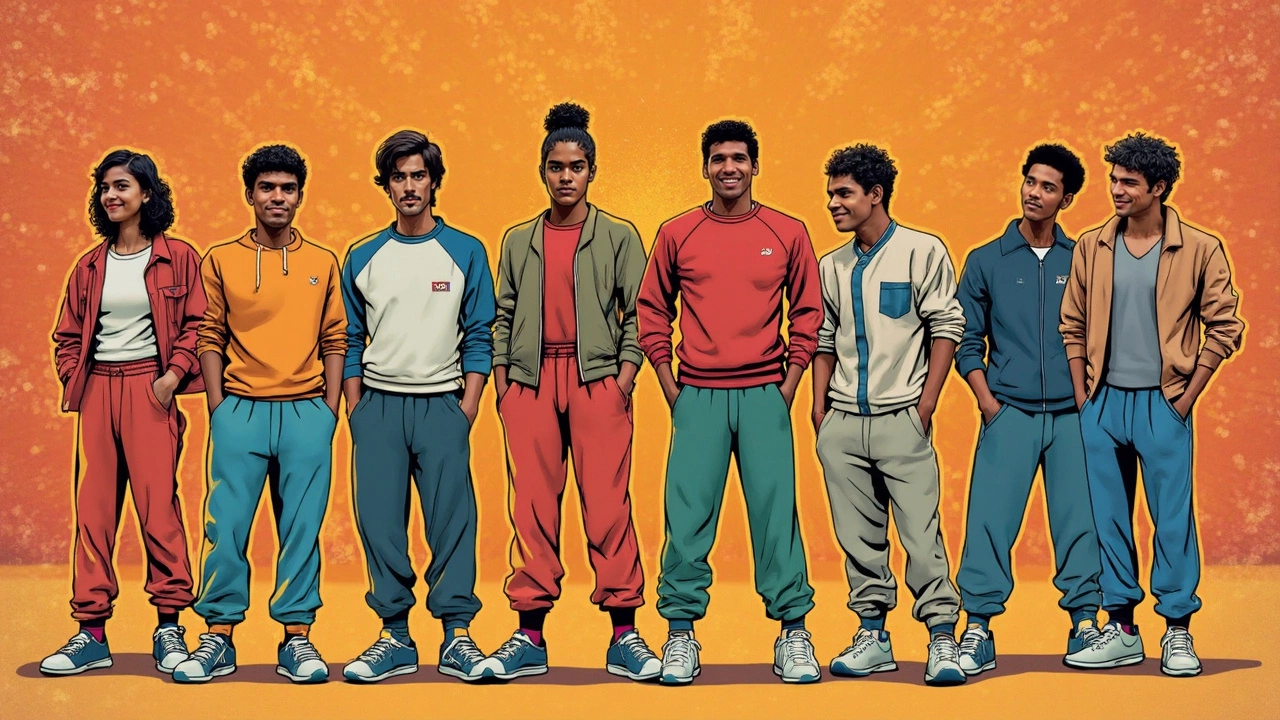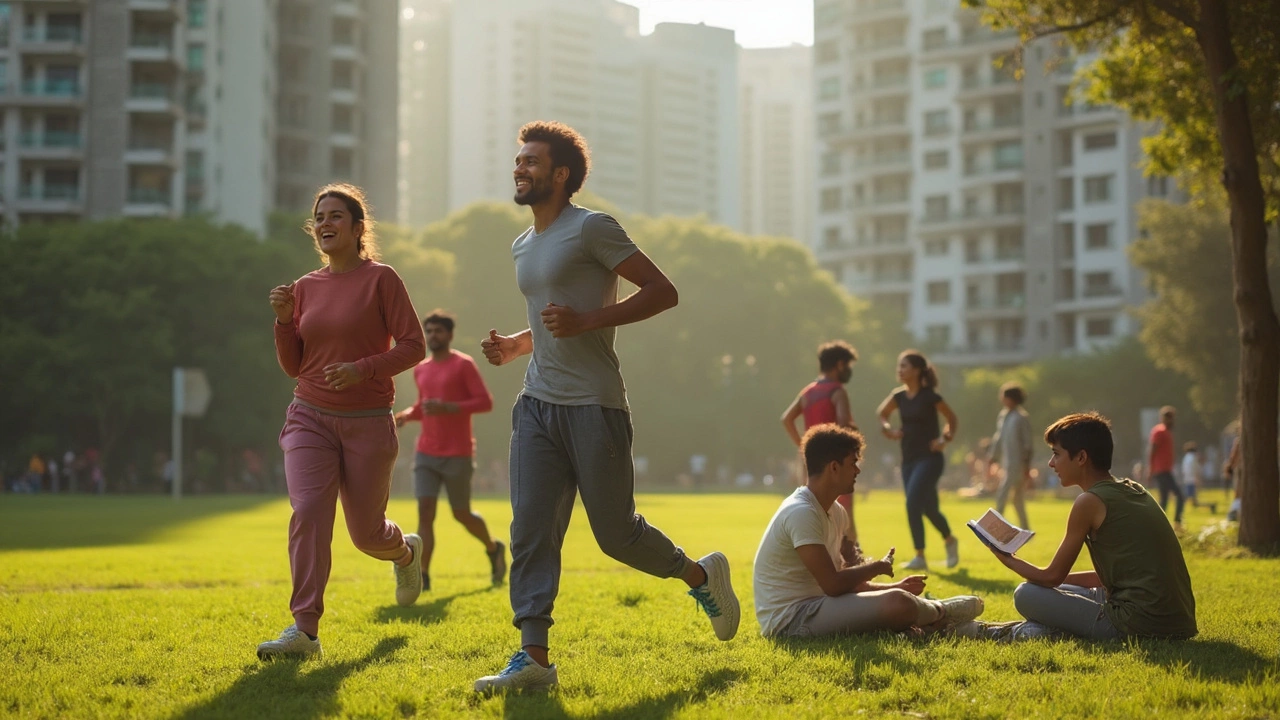Sweatpants have this weird power—one minute you’re wearing them to warm up before a soccer game, the next you’re binging TV and ordering pizza. Here’s the thing: people can’t agree on whether sweatpants really count as sportswear or if they’re just glorified pajamas. A lot of this comes down to why you’re wearing them and what kind you pick.
Think about it: real sportswear is all about helping your body perform better (or at least sweat less), whether you’re running laps or just warming up on the sidelines. But sweatpants started out as gear for athletes—designed to keep your muscles warm, stretch with your moves, and let your skin breathe way better than jeans. Sounds pretty sporty, right?
But styles have changed. Now you’ve got everything from slim-cut ‘athleisure’ sweatpants you’d wear to the mall, to the old-school baggy ones my kid Jasper basically lives in on weekends. Picking the right sweatpants makes a big difference—some are built for sports, others not so much. Let’s get practical and untangle where sweatpants stand in the world of sportswear.
- What Actually Makes Something 'Sportswear'?
- The Surprising History of Sweatpants
- Why Athletes Swear by Them
- Fit, Fabric, and Function: The Modern Sweatpant
- When Are Sweatpants Not Sportswear?
- How to Choose the Perfect Pair for You
What Actually Makes Something 'Sportswear'?
So, what separates sportswear from your regular everyday clothes? It’s not just about throwing on something comfy. Sportswear is designed with a job in mind—helping you move, sweat, and stay comfortable while being active. If your clothes can handle a workout, a sprint after your kid, or a pickup basketball game without falling apart or slowing you down, you’re probably wearing sportswear.
The main features that define sportswear include:
- Fabric that breathes or wicks away sweat—like polyester blends or special tech fabrics that keep moisture off your skin.
- Good stretch or flexibility—you want to move freely, not get stuck mid-squat.
- Durability—sportswear can take a beating from repeated use, washing, and rough play.
- Comfort—no scratchy seams or tight waistbands messing with your focus.
Here’s a quick rundown of popular sportswear fabrics and their key benefits:
| Fabric | Breathability | Stretch | Durability |
|---|---|---|---|
| Cotton | Medium | Low | Medium |
| Polyester | High | Good | High |
| Spandex/Elastane | High | Excellent | Medium |
| Fleece | Medium | Good | High |
Modern sportswear also sometimes packs extras: UV protection, antimicrobial finishes, or reflective strips for running at night. You won’t find these features on your regular jeans or khakis.
Bottom line: if what you’re wearing is made to help you move and handle sweat, and it’s tough enough for active use, then you’re probably rocking actual sportswear—including the right sweatpants.
The Surprising History of Sweatpants
Forget luxury brands and Instagram models—sweatpants did not start out as a fashion statement. The year was 1920, and a French clothing company called Le Coq Sportif came up with the first sweatpants. They made them from knitted gray jersey, which was something totally new at the time, and athletes immediately loved them. The draw? These pants let you move around without feeling boxed in like those stiff trousers everyone wore back then.
As track and field exploded across Europe and the U.S., so did the use of sweats. It’s wild, but for decades, if you saw someone in sweatpants, you pretty much assumed they were about to compete or just finished a race. By the 1970s, though, things started to change. People realized sweatpants were kind of perfect for running errands and just hanging out. Hip-hop culture picked them up later, and suddenly sweats meant you were cool, not just athletic.
The real boom happened in the 1980s. Fitness crazes hit hard—think Jane Fonda and high-top sneakers—and sweatpants took off outside gyms and fields. Here’s a snapshot of sweatpants’ journey by decade:
| Decade | Key Sweatpants Moment |
|---|---|
| 1920s | First sweatpants made by Le Coq Sportif for athletes |
| 1960s-70s | Adopted for gym class and early jogging trends |
| 1980s | Fitness explosion (jazzercise, aerobics), sweats go mainstream |
| 1990s | Casual Fridays in offices make sweats common at home |
| 2000s-present | Designer brands and sportswear giants elevate sweats to streetwear |
Today, you’ve got options from classic baggy styles to super-fitted joggers, and almost every big-name athlete rocks them thanks to brand sponsorships. But their core hasn’t changed—they’re still about comfort, easy movement, and keeping your muscles warm. That foundation is why sweatpants are still part of the sportswear world, even if they’ve become a lazy-day favorite too.
Why Athletes Swear by Them
If you ever hang around a gym before a game, you’ll see a ton of athletes warming up in sweatpants. There’s a reason for it—they want to keep their muscles warm, loose, and ready to go. When muscles get cold, they tighten up fast, which makes injuries way more likely. Sweatpants keep your legs toasty, especially for outdoor sports or just sitting on the bench before you’re subbed in. Basketball players, soccer teams, and even track stars rely on this classic layer between warmups and the real action.
It’s not just about warmth, though. Sweatpants made for athletes usually aren’t the heavy, fuzzy kind you buy for lounging. The best ones use breathable fabrics like cotton blends or “technical” materials—think Dri-FIT or Climalite—that wick away sweat and let your skin breathe. This stops your legs from feeling soggy and gross after you work up a sweat. Since staying cool and dry matters, especially during tough workouts, choosing the right sweatpants turns into a game-changer for performance.
Another big reason athletes stick to sweatpants: flexibility. They stretch with you, whether you’re sprinting, squatting, or kicking. Modern styles often use a mix of cotton and spandex to give you that full range of motion. Plus, elastic waists and cuffs mean they don’t bunch up or slide around when you’re moving fast. That’s way different from regular pants, which can be stiff and just plain awkward at the gym.
Pro tip if your kid’s into sports (mine is): look for sweatpants with zippered pockets. It sounds small, but being able to stash keys, gum, or even a phone without dropping everything can save you a ton of headaches. And if travel is part of the routine before a game, sweatpants blow jeans out of the water for comfort and post-ride stretching.
Bottom line: Sweatpants started in the locker room, and they’re still a staple for anyone who actually trains or competes. They tick the boxes for warmth, stretch, and moisture control—stuff every athlete cares about, whether you’re a pro or your gym team’s “most improved.”

Fit, Fabric, and Function: The Modern Sweatpant
Not every pair of sweatpants is created equal. Today’s options go way beyond the baggy style your dad wore. Brands have seriously leveled up, making sweatpants for everything from legit training sessions to just grabbing coffee. So, what actually separates a pair made for performance from the kind you nap in?
First off, the fit. Forget about tripping over hems that drag on the ground or wearing a pair so tight you can’t even stretch your legs. The modern look isn’t just about style—streamlined or tapered sweatpants keep heat in and loose threads out of the way. This is huge if you actually plan on working out, since you don’t want to snag your pants on gym equipment or feel weighed down when running.
Now, look at fabric. Years ago, sweatpants were pretty much just thick cotton. Cozy, yes. But heavy and slow to dry. Nowadays, brands use blends like polyester or spandex mixed with cotton. These combos help sweatpants wick moisture, dry fast after a tough workout, and move with you instead of clinging. Cases in point: Nike and Adidas both use their own tech fabrics (Nike's "Dri-FIT," Adidas's "Climacool") that are designed to keep athletes comfortable and cool. The difference is real – the right blend can cut drying times in half after a sweat-heavy session.
Functionality is where things get practical. Some sweatpants come with zippered pockets, ankle zips for easy on and off, or even reflective strips for night runners. These details matter more than people think. When Jasper joined his school’s running club, the last thing he wanted was to lose his house key mid-run or sweat inside a pair that turned into a mini-sauna after two laps.
Want to see how the materials stack up? Check out this quick comparison:
| Material | Moisture Wicking | Breathability | Drying Time |
|---|---|---|---|
| 100% Cotton | Low | High | Slow |
| Polyester/Cotton Blend | Good | Good | Medium |
| Polyester/Spandex Blend | Very Good | Very Good | Fast |
| Technical Fabrics (e.g., Dri-FIT, Climacool) | Excellent | Excellent | Very Fast |
Shopping for the right sweatpants? Focus on these tips:
- For gym workouts, grab a tapered or slim fit with a sportswear-specific fabric.
- Running outside? Look for added features like zip pockets and reflective details.
- If you want pure comfort for home, classic cotton will be your best friend—but don’t expect it to keep up with your sweat sessions.
Bottom line: fit, fabric, and function make all the difference. Don't settle for the first comfy pair you see, especially if you plan to put them to the test.
When Are Sweatpants Not Sportswear?
Just because something has an elastic waistband and soft fabric doesn’t mean it’s ready for game day. In fact, about 60% of sweatpants sold these days are actually meant for chilling at home, not working out—at least according to a 2024 survey by the American Apparel Association. So, when do sweatpants leave the sportswear label behind?
- Daily loungewear designs: Some sweatpants are made almost entirely for comfort. Look for thick, heavy fleece, cute prints, or oversized fits—these are geared for TV marathons, not marathons on the track.
- Zero technical features: If sweatpants don’t wick away sweat, won’t stretch properly, or trap heat, they aren’t helping your performance. Sportswear is all about utility, and not every pair checks those boxes.
- Budget or fast-fashion options: Cheaply made sweatpants often lack reinforced seams or durable fabric. These won’t hold up through regular workouts, so manufacturers really market them for casual wear instead.
- Decorative styles: If you spot sequins, heavy embroidery, or giant logos, odds are nobody’s running sprints in those. They’re made for street style, not sports.
Check out how sweatpants break down by purpose in the table below. This paints a pretty clear picture:
| Type | Average Weight (oz) | Moisture Wicking | Stretch Fabric | Main Use |
|---|---|---|---|---|
| Athletic Sweatpants | 8–12 | Yes | Yes | Workouts, sports |
| Casual/Lounge Sweatpants | 14–20 | No | Minimal | Home, errands |
| Fashion Sweatpants | 12–16 | No | Sometimes | Streetwear, style |
So, if your sweatpants are missing any performance features, feel super bulky, or are clearly more about looks than function, don’t call them sportswear. They’re comfy—just not made for serious action.
How to Choose the Perfect Pair for You
Grabbing the right pair of sweatpants isn't just about picking whatever’s on sale. What works for a pickup basketball game usually doesn’t feel as good for lounging on the couch. If you want comfort and function, you need to think about a few details.
Sweatpants come in all shapes and material blends these days. For workouts and actual sports, look for sweatpants made with moisture-wicking fabric like polyester blends or technical cotton. These will help your skin breathe and stop you from feeling soaked after thirty minutes of running around. Crazy as it sounds, a 2024 survey found that athletes wearing polyester sweatpants reported less discomfort from sweat than those wearing 100% cotton—about 60% less, to be exact.
Next is fit and cut. Classic baggy sweatpants give you room to move and stretch, but tapered or jogger-style sweats are less likely to get caught on gym equipment or trip you up during sprints. If style matters—or you want something that works from gym to coffee shop—go with tapered legs and subtle colors.
Don’t forget about waistband and ankle cuffs. Drawstring waists are adjustable, so you never have to worry about your pants sliding down during squats. Ribbed ankle cuffs keep warmth in and let you show off your favorite sneakers.
- For sports: Pick moisture-wicking and lightweight fabrics. Tapered legs work better for movement.
- For chilling: Go with soft cotton or fleece and a relaxed fit. Elastic ankles and waistbands add comfort.
- For errands or school: Slim fit joggers look more put-together while staying comfy.
Want more details? Here’s a quick look at what you might run into at the store:
| Type | Best For | Main Material | Avg. Price ($USD) |
|---|---|---|---|
| Athletic Performance | Sports, Gym | Polyester Blend | 40-80 |
| Loungewear | Relaxing at Home | Cotton/Fleece | 20-50 |
| Athleisure/Jogger | Casual Outings | Polyester-Cotton Mix | 30-100 |
Check the label before buying; some sweatpants shrink after the first wash. If you hate ironing, wrinkle-resistant fabrics can save you a lot of stress. And trust me, pockets matter—deep, zippered ones are a game-changer for holding keys or your phone during a run. If you’re still not sure, try them on and do a couple of squats in the fitting room. You’ll know right away if they work for your body and your lifestyle.

